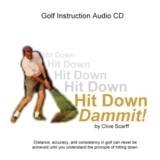Distance & Technology Part 2: Driver
Loft
Read Part 1 of this
series here.
Over the next few
months, as we lead
up to a new golf
season for everyone,
the topic of my newsletter
will be how new Driver
Technology provides
greater distance
to us all. If you
have been thinking
of purchasing a new
driver this season,
hold off until you
get a better understanding
of what's out there.
If there is any
topic you would like
explained and presented
in my upcoming newsletters,
just email me. I'll
attempt to cover
your topic in a future
newsletter.
If you'd
like one on
one explanations
about the topic,
sign up for the PGI
Member Select Club and
I'll answer all your
questions. Now on
to this week's topic.
I. Clubhead
Loft
Other
than environmental
conditions, the
three major determinants
of distance for
a golf ball are:
clubhead speed,
initial trajectory
angle and initial
backspin. For the
most part, the
club can't do much
for your clubhead
speed (as long
as it has optimum
mass, see Part
1), but it can
play a major roll
in trajectory angle
and backspin. If
there were no air,
the ball's backspin
would not have
any effect and
the optimum launch
angle would be
45 degrees. The
ball would not
go anywhere near
as far as it goes
in air (see here
for more).
Backspin creates
a lot of lift for
the ball which
keeps it in the
air longer, so
it can fly farther.
The
initial trajectory
angle and backspin
are greatly affected
by the loft of
the club and its
center of mass
(the path of the
club, ascending
or descending,
also plays a role).
The loft which
optimizes distance
depends on clubhead
speed. The greater
the clubhead speed,
the lower the desired
loft angle. For
a short hitter,
the optimum loft
might be 16 degrees
(which means a
3 wood loft), while
for a longer hitter,
the optimum angle
might be 12 degrees.
Club
manufacturers will
clearly label
the loft of the
driver but make
no mention of
the center of mass,
another important
factor. A low center
of mass will increase
the launch angle
thus increasing
the effective loft
of the club. Since
there is no easy
way to measure
where the center
of mass of a club
is, it's important
that the golfer
experiment with
different lofts
of the same type
of driver. A 12
degree loft in
one driver won't
be the same as
the 12 degree loft
in another driver.
Most
golfers should
play a driver
which has a center
of
mass that is
low and back from
the
face of the club.
This will promote
higher trajectory
without having
to have too much
loft. The greater
the loft of the
clubface, the
smaller will be
the ball
speed. One wants
optimum trajectory
with maximum
ball speed. Having
the
center of mass
back from the
face will also
mean
the club will
twist less on off
center
hits (which occur
more often than not).
Play
with my Driver
Distance Calculator.
You can input such
variables as loft
and clubhead speed
to determine the
optimum loft.
If
you are serious
about
trying to optimize
your distance through
clubhead loft, go
to a facility that
has a club/ball monitor
(one that measures
clubhead speed, ball
speed, trajectory,
spin, etc). You can
experiment with different
clubhead lofts to
find the one that
produces optimum ball speed,
trajectory and spin.
A list of resources that have been used to produce this newsletter
can be found on my
website here.
The next newsletter's topic will be the driver shaft. What is
its optimum mass and
stiffness for greatest
distance?
The focus
of my site
is to utilize science
and math to lower
your score. New technology
is one
way to achieve this,
but to be honest,
the technology is
one small piece of
the puzzle.
To actually improve significantly,
we all need to:
1. Improve our swings. Hit
Down Dammit!
2. Improve our physical fitness
and strength.
The
Golf Trainer Power
Performance Programô
3. Improve our mental games.
Golf Mind Software
4. Improve our Probable
Golf games.
Learn how to make better
choices on the course
through knowing how
shot patterns and reading
the elements and course
better.
Click on the links above to
take a look at
ways that I personally
use myself and
recommend you try
as well.
One last mention of my latest study on amateur golf scores
and handicaps.
There
are 3 reports:
Report
#1:
Team Events
Report
#2:
Match
Play & Stroke
Allocation
Report
#3:
Birdie
Ratios & Other
Scores
Each
report can be downloaded
immediately for $7.99
or all three can
be purchased for
$19.99.
For
Newsletter Members
Only (that's you),
all three reports
can be purchased
for a special discounted
price of $14.99,
but only by using
the link below.
Take
a closer look at
some of the details
of the reports HERE,
and then come back
here to order.
Pay
$14.99 thru 2CheckOut 
Goods and services
provided by Probable
Golf Instruction
(BC, Canada).
Sold by 2CheckOut.com Inc. (Ohio, USA).
Once
processed by
2CheckOut, you
will be prompted
with a link to
download. Since
the time is very
limited, you
should download
immediately.
OR
Pay
using
Hope
I provided some useful
ways for to become
better prepared for
you best golf season
ever.
Ken Tannar
|







